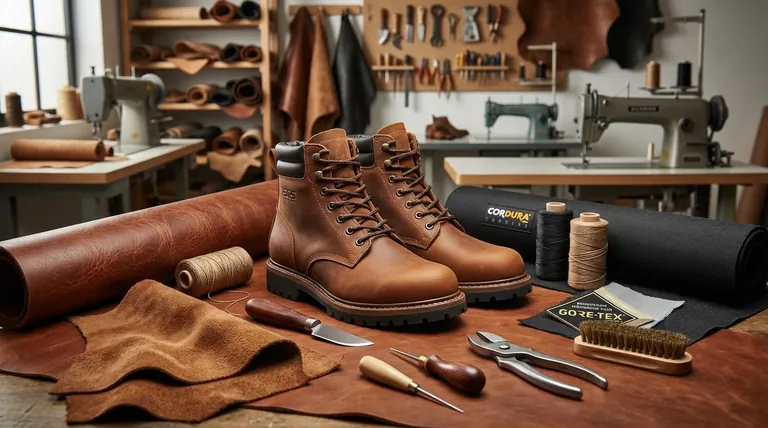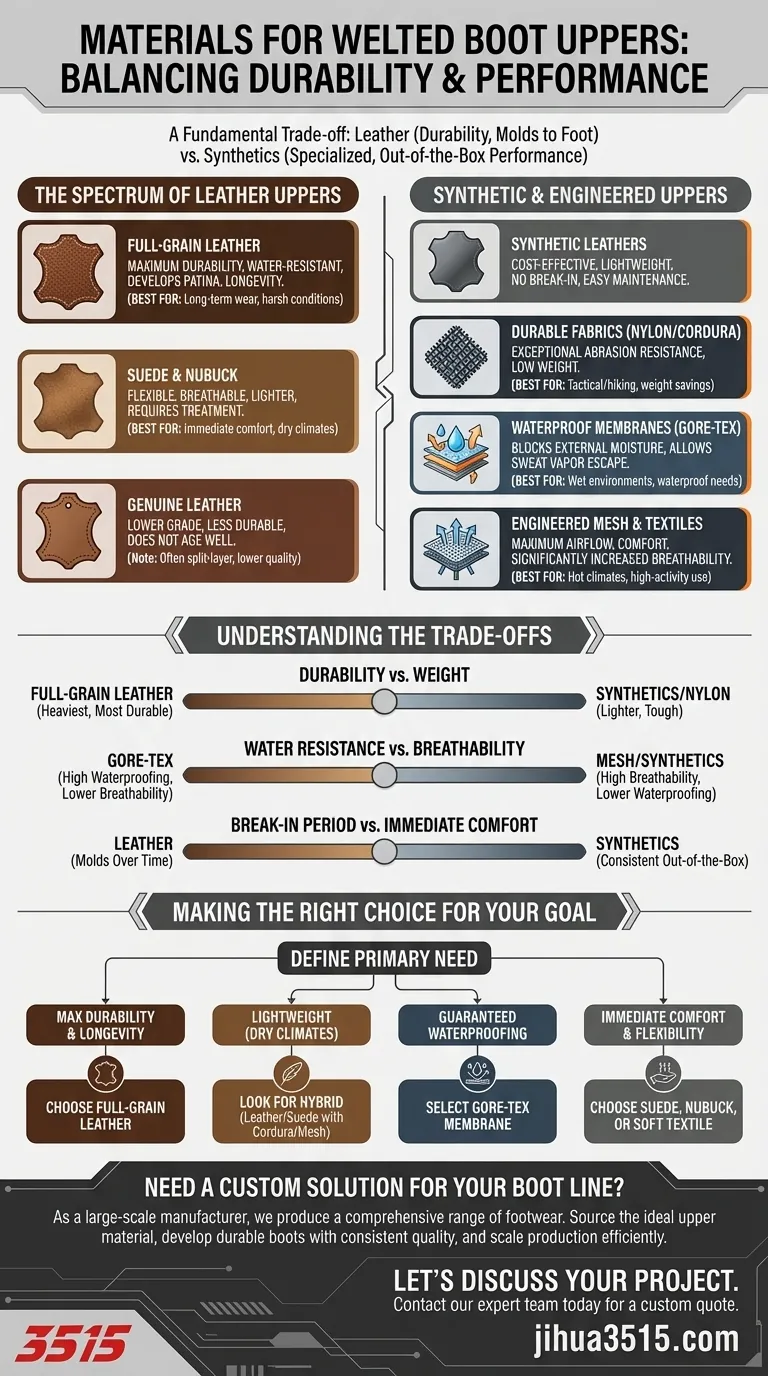In short, the upper part of welted boots is almost always made from some form of leather or advanced synthetic material. The most common choices are full-grain leather for maximum durability, suede or nubuck for flexibility, and engineered textiles like Cordura or GORE-TEX for lightweight, specialized performance.
The choice of an upper material is a fundamental trade-off. Leather offers unmatched durability and the ability to mold to your foot over time, while synthetic materials provide specialized, out-of-the-box performance for specific conditions like extreme wetness or heat.

The Spectrum of Leather Uppers
Leather is the traditional and often premium choice for boot uppers, valued for its durability, breathability, and classic aesthetic. However, not all leather is created equal.
Full-Grain Leather
Full-grain leather is the highest quality grade. It comes from the top layer of the hide and includes all the natural grain, making it incredibly tough, durable, and water-resistant. Its primary advantage is its longevity and ability to develop a unique patina over time.
Suede, Nubuck, and Split-Grain Leather
These leathers are created by sanding or splitting the hide, resulting in a softer, napped texture. Suede and nubuck offer excellent flexibility and breathability from the start. They are lighter than full-grain leather but are generally less resistant to water and stains unless treated.
A Note on "Genuine Leather"
While the term sounds premium, "genuine leather" is often a lower-quality grade made from the layers of the hide that remain after the top is split off. It is less durable and does not age as well as full-grain or top-grain options.
The Rise of Synthetic & Engineered Uppers
Modern technology has produced a wide range of synthetic materials that offer targeted performance benefits, often surpassing leather in specific scenarios.
Synthetic Leathers
Synthetic leather provides a cost-effective and lightweight alternative to real leather. While it doesn't offer the same durability or breathability, it requires no break-in period and is easier to maintain.
Durable Fabrics (Nylon & Cordura)
Materials like nylon and Cordura are prized for their exceptional abrasion resistance and low weight. They are often used in panels on tactical or hiking boots to add durability without the bulk of full leather.
Waterproof Membranes (GORE-TEX & Sympatex)
Specialized waterproof-breathable membranes like GORE-TEX are a game-changer for wet conditions. They are laminated to the inner side of the upper material to block external moisture while allowing sweat vapor to escape, keeping your feet dry from both the inside and out.
Engineered Mesh & Textiles
For boots designed for hot climates or high-output activity, engineered mesh panels are integrated into the upper. These textiles provide maximum airflow and comfort, significantly increasing breathability at the expense of water resistance.
Understanding the Trade-offs
Choosing an upper material is a balancing act. No single material is superior in all categories; the right choice depends entirely on your intended use.
Durability vs. Weight
Full-grain leather is the undisputed champion of long-term durability but is also the heaviest option. Synthetics like nylon and Cordura offer excellent toughness for their weight, providing a more balanced choice for active use.
Water Resistance vs. Breathability
Leather has natural water resistance, which can be enhanced with conditioning. However, waterproof membranes like GORE-TEX offer a more reliable barrier. This waterproofing often comes at the cost of some breathability, a trade-off that synthetics with mesh panels invert completely.
Break-in Period vs. Immediate Comfort
A key characteristic of high-quality leather boots is the break-in period, during which the stiff material molds perfectly to your foot. Synthetic materials, by contrast, offer consistent comfort right out of the box but will not conform in the same way over time.
Making the Right Choice for Your Goal
To select the best material, you must first define your primary need.
- If your primary focus is maximum durability and longevity: Choose a boot with a full-grain leather upper.
- If your primary focus is lightweight performance in dry climates: Look for a hybrid upper combining leather or suede with Cordura or mesh panels.
- If your primary focus is guaranteed waterproofing: Select a boot that explicitly features a GORE-TEX or similar waterproof-breathable membrane.
- If your primary focus is immediate comfort and flexibility: Suede, nubuck, or a soft textile upper will provide the best out-of-the-box feel.
Ultimately, understanding the properties of these materials empowers you to choose a boot that performs as a reliable tool for your specific needs.
Summary Table:
| Material Type | Key Characteristics | Best For |
|---|---|---|
| Full-Grain Leather | Maximum durability, develops patina, water-resistant | Long-term wear, harsh conditions |
| Suede/Nubuck | Soft, flexible, breathable | Immediate comfort, dry climates |
| Synthetics (Nylon/Cordura) | Lightweight, abrasion-resistant | Tactical/hiking boots, weight savings |
| Waterproof Membranes (GORE-TEX) | Blocks moisture, breathable | Wet environments, waterproof needs |
| Engineered Mesh | Maximum airflow, lightweight | Hot climates, high-activity use |
Need a Custom Solution for Your Boot Line?
As a large-scale manufacturer, 3515 produces a comprehensive range of footwear for distributors, brand owners, and bulk clients. Our production capabilities encompass all types of shoes and boots, ensuring you get the perfect material and construction for your market.
We can help you:
- Source the ideal upper material for your target audience's needs.
- Develop durable, high-performance boots with consistent quality.
- Scale production efficiently to meet your bulk order requirements.
Let's discuss your project: Contact our expert team today to get a custom quote and see how we can bring your boot designs to life.
Visual Guide

Related Products
- Durable Leather Work Boots for Wholesale & Custom OEM Manufacturing
- Durable Leather Work Boots for Wholesale & Custom Manufacturing
- Durable Leather Tactical Boots Wholesale & Custom Manufacturing for Brands
- Durable Goodyear Welt Leather Work Boots for Wholesale & Private Label
- Safety Footwear Wholesale Manufacturer for Custom OEM/ODM Production
People Also Ask
- Why is breaking in work boots important? Ensure Long-Term Comfort and Durability
- Who benefits most from wearing work boots? Essential Foot Protection for Hazardous Jobs
- How should one choose between work boots and dress boots? Find the Right Boot for Your Needs
- Which brands are known for high-quality work boots? A Guide to Durable, Safe Footwear
- How should work boots be stored? Protect Your Investment with Proper Storage



















